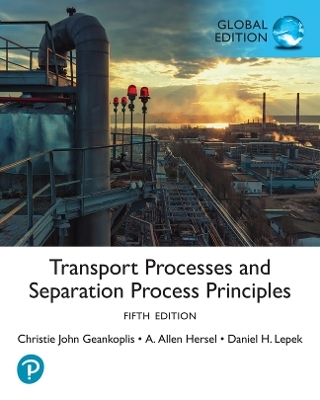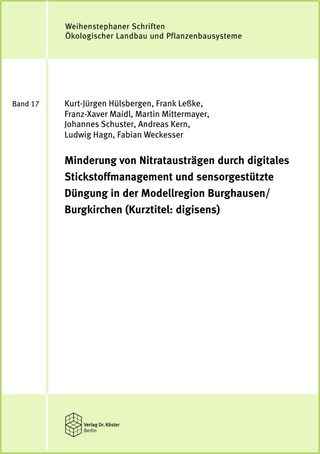
Transport Processes and Separation Process Principles, Global Edition
Pearson Education Limited (Verlag)
9781292445915 (ISBN)
About our authors Christie John Geankoplis was a professor of chemical engineering and materials science at the University of Minnesota. His research interests involved transport processes, biochemical reactor engineering, mass transfer in liquid solutions, and diffusion and/or reaction in porous solids. Allen Hersel is an associate professor in the Department of Chemical Engineering at Trine University in Angola, Indiana, where he teaches transport phenomena and separations for the last 19 years. He also served as the dean of the engineering school. His area of research is bio-separations and engineering education. Before entering academia, he worked for Koch Industries and Kellogg Brown & Root. He holds a Ph.D. in chemical engineering from Yale University. Daniel H. Lepek is a professor at the Department of Chemical Engineering at The Cooper Union. His research interests include particle technology, fluidization and multi-phase flow, pharmaceutical engineering, modeling of transport and bio-transport phenomena, and engineering education. He is an active member of the American Institute of Chemical Engineers (AIChE) and the American Society of Engineering Education (ASEE). He received a Bachelor of Engineering degree in Chemical Engineering from The Cooper Union and received his Ph.D. in Chemical Engineering from New Jersey Institute of Technology (NJIT).
Part 1: Transport Processes: Momentum, Heat, and Mass
Introduction to Engineering Principles and Units
Chapter Objectives
Classification of Transport Processes and Separation Processes (Unit Operations)
SI System of Basic Units Used in This Text and Other Systems
Methods of Expressing Temperatures and Compositions
Gas Laws and Vapor Pressure
Conservation of Mass and Material Balances
Energy and Heat Units
Conservation of Energy and Heat Balances
Numerical Methods for Integration
Chapter Summary
Introduction to Fluids and Fluid Statics
Chapter Objectives
Introduction
Fluid Statics
Chapter Summary
Fluid Properties and Fluid Flows
Chapter Objectives
Viscosity of Fluids
Types of Fluid Flow and Reynolds Number
Chapter Summary
Overall Mass, Energy, and Momentum Balances
Chapter Objectives
Overall Mass Balance and Continuity Equation
Overall Energy Balance
Overall Momentum Balance
Shell Momentum Balance and Velocity Profile in Laminar Flow
Chapter Summary
Incompressible and Compressible Flows in Pipes
Chapter Objectives
Design Equations for Laminar and Turbulent Flow in Pipes
Compressible Flow of Gases
Measuring the Flow of Fluids
Chapter Summary
Flows in Packed and Fluidized Beds
Chapter Objectives
Flow Past Immersed Objects
Flow in Packed Beds
Flow in Fluidized Beds
Chapter Summary
Pumps, Compressors, and Agitation Equipment
Chapter Objectives
Pumps and Gas-Moving Equipment
Agitation, Mixing of Fluids, and Power Requirements
Chapter Summary
Differential Equations of Fluid Flow
Chapter Objectives
Differential Equations of Continuity
Differential Equations of Momentum Transfer or Motion
Use of Differential Equations of Continuity and Motion
Chapter Summary
Non-Newtonian Fluids
Chapter Objectives
Non-Newtonian Fluids
Friction Losses for Non-Newtonian Fluids
Velocity Profiles for Non-Newtonian Fluids
Determination of Flow Properties of Non-Newtonian Fluids Using a Rotational Viscometer
Power Requirements in Agitation and Mixing of Non-Newtonian Fluids
Chapter Summary
Potential Flow and Creeping Flow
Chapter Objectives
Other Methods for Solution of Differential Equations of Motion
Stream Function
Differential Equations of Motion for Ideal Fluids (Inviscid Flow)
Potential Flow and Velocity Potential
Differential Equations of Motion for Creeping Flow
Chapter Summary
Boundary-Layer and Turbulent Flow
Chapter Objectives
Boundary-Layer Flow
Turbulent Flow
Turbulent Boundary-Layer Analysis
Chapter Summary
Introduction to Heat Transfer
Chapter Objectives
Energy and Heat Units
Conservation of Energy and Heat Balances
Conduction and Thermal Conductivity
Convection
Radiation
Heat Transfer with Multiple Mechanisms/Materials
Chapter Summary
Steady-State Conduction
Chapter Objectives
Conduction Heat Transfer
Conduction Through Solids in Series or Parallel with Convection
Conduction with Internal Heat Generation
Steady-State Conduction in Two Dimensions Using Shape Factors
Numerical Methods for Steady-State Conduction in Two Dimensions
Chapter Summary
Principles of Unsteady-State Heat Transfer
Chapter Objectives
Derivation of the Basic Equation
Simplified Case for Systems with Negligible Internal Resistance
Unsteady-State Heat Conduction in Various Geometries
Numerical Finite-Difference Methods for Unsteady-State Conduction
Chilling and Freezing of Food and Biological Materials
Differential Equation of Energy Change
Chapter Summary
Introduction to Convection
Chapter Objectives
Introduction and Dimensional Analysis in Heat Transfer
Boundary-Layer Flow and Turbulence in Heat Transfer
Forced Convection Heat Transfer Inside Pipes
Heat Transfer Outside Various Geometries in Forced Convection
Natural Convection Heat Transfer
Boiling and Condensation
Heat Transfer of Non-Newtonian Fluids
Special Heat-Transfer Coefficients
Chapter Summary
Heat Exchangers
Chapter Objectives
Types of Exchangers
Log-Mean-Temperature-Difference Correction Factors
Heat-Exchanger Effectiveness
Fouling Factors and Typical Overall U Values
Double-Pipe Heat Exchanger
Chapter Summary
Heat Exchangers
Chapter Objectives
Types of Exchangers
Log-Mean-Temperature-Difference Correction Factors
Heat-Exchanger Effectiveness
Fouling Factors and Typical Overall U Values
Double-Pipe Heat Exchanger
Chapter Summary
Introduction to Radiation Heat Transfer
Chapter Objectives
Introduction to Radiation Heat-Transfer Concepts
Basic and Advanced Radiation Heat-Transfer Principles
Chapter Summary
Introduction to Mass Transfer
Chapter Objectives
Introduction to Mass Transfer and Diffusion
Diffusion Coefficient
Convective Mass Transfer
Molecular Diffusion Plus Convection and Chemical Reaction
Chapter Summary
Steady-State Mass Transfer
Chapter Objectives
Molecular Diffusion in Gases
Molecular Diffusion in Liquids
Molecular Diffusion in Solids
Diffusion of Gases in Porous Solids and Capillaries
Diffusion in Biological Gels
Special Cases of the General Diffusion Equation at Steady State
Numerical Methods for Steady-State Molecular Diffusion in Two Dimensions
Chapter Summary
Unsteady-State Mass Transfer
Chapter Objectives
Unsteady-State Diffusion
Unsteady-State Diffusion and Reaction in a Semi-Infinite Medium
Numerical Methods for Unsteady-State Molecular Diffusion
Chapter Summary
Convective Mass Transfer
Chapter Objectives
Convective Mass Transfer
Dimensional Analysis in Mass Transfer
Mass-Transfer Coefficients for Various Geometries
Mass Transfer to Suspensions of Small Particles
Models for Mass-Transfer Coefficients
Chapter Summary
Part 2: Separation Process Principles
Absorption and Stripping
Chapter Objectives
Equilibrium and Mass Transfer Between Phases
Introduction to Absorption
Pressure Drop and Flooding in Packed Towers
Design of Plate Absorption Towers
Design of Packed Towers for Absorption
Efficiency of Random-Packed and Structured Packed Towers
Absorption of Concentrated Mixtures in Packed Towers
Estimation of Mass-Transfer Coefficients for Packed Towers
Heat Effects and Temperature Variations in Absorption
Chapter Summary
Humidification Processes
Chapter Objectives
Vapor Pressure of Water and Humidity
Introduction and Types of Equipment for Humidification
Theory and Calculations for Cooling-Water Towers
Chapter Summary
Filtration and Membrane Separation Processes (Liquid–Liquid or Solid–Liquid Phase)
Chapter Objectives
Introduction to Dead-End Filtration
Basic Theory of Filtration
Membrane Separations
Microfiltration Membrane Processes
Ultrafiltration Membrane Processes
Reverse-Osmosis Membrane Processes
Dialysis
Chapter Summary
Gaseous Membrane Systems
Chapter Objectives
Gas Permeation
Complete-Mixing Model for Gas Separation by Membranes
Complete-Mixing Model for Multicomponent Mixtures
Cross-Flow Model for Gas Separation by Membranes
Derivation of Equations for Countercurrent and Cocurrent Flow for Gas Separation by Membranes
Derivation of Finite-Difference Numerical Method for Asymmetric Membranes
Chapter Summary
Distillation
Chapter Objectives
Equilibrium Relations Between Phases
Single and Multiple Equilibrium Contact Stages
Simple Distillation Methods
Binary Distillation with Reflux Using the McCabe–Thiele and Lewis Methods
Tray Efficiencies
Flooding Velocity and Diameter of Tray Towers Plus Simple Calculations for Reboiler and Condenser Duties
Fractional Distillation Using the Enthalpy–Concentration Method
Distillation of Multicomponent Mixtures
Chapter Summary
Liquid–Liquid Extraction
Chapter Objectives
Introduction to Liquid–Liquid Extraction
Single-Stage Equilibrium Extraction
Types of Equipment and Design for Liquid–Liquid Extraction
Continuous Multistage Countercurrent Extraction
Chapter Summary
Adsorption and Ion Exchange
Chapter Objectives
Introduction to Adsorption Processes
Batch Adsorption
Design of Fixed-Bed Adsorption Columns
Ion-Exchange Processes
Chapter Summary
Crystallization and Particle Size Reduction
Chapter Objectives
Introduction to Crystallization
Crystallization Theory
Mechanical Size Reduction
Chapter Summary
Settling, Sedimentation, and Centrifugation
Chapter Objectives
Settling and Sedimentation in Particle–Fluid Separation
Centrifugal Separation Processes
Chapter Summary
Leaching
Chapter Objectives
Introduction and Equipment for Liquid–Solid Leaching
Equilibrium Relations and Single-Stage Leaching
Countercurrent Multistage Leaching
Chapter Summary
Evaporation
Chapter Objectives
Introduction
Types of Evaporation Equipment and Operation Methods
Overall Heat-Transfer Coefficients in Evaporators
Calculation Methods for Single-Effect Evaporators
Calculation Methods for Multiple-Effect Evaporators
Condensers for Evaporators
Evaporation of Biological Materials
Evaporation Using Vapor Recompression
Chapter Summary
Drying
Chapter Objectives
Introduction and Methods of Drying
Equipment for Drying
Vapor Pressure of Water and Humidity
Equilibrium Moisture Content of Materials
Rate-of-Drying Curves
Calculation Methods for a Constant-Rate Drying Period
Calculation Methods for the Falling-Rate Drying Period
Combined Convection, Radiation, and Conduction Heat Transfer in the Constant-Rate Period
Drying in the Falling-Rate Period by Diffusion and Capillary Flow
Equations for Various Types of Dryers
Freeze-Drying of Biological Materials
Unsteady-State Thermal Processing and Sterilization of Biological Materials
Chapter Summary
Part 3: Appendixes
Appendix A.1 Fundamental Constants and Conversion Factors
Appendix A.2 Physical Properties of Water
Appendix A.3 Physical Properties of Inorganic and Organic Compounds
Appendix A.4 Physical Properties of Foods and Biological Materials
Appendix A.5 Properties of Pipes, Tubes, and Screens
Appendix A.6 Lennard-Jones Potentials as Determined from Viscosity Data
Notation
Index
| Erscheinungsdatum | 14.11.2022 |
|---|---|
| Verlagsort | Harlow |
| Sprache | englisch |
| Maße | 210 x 270 mm |
| Gewicht | 2170 g |
| Themenwelt | Technik ► Umwelttechnik / Biotechnologie |
| ISBN-13 | 9781292445915 / 9781292445915 |
| Zustand | Neuware |
| Informationen gemäß Produktsicherheitsverordnung (GPSR) | |
| Haben Sie eine Frage zum Produkt? |
aus dem Bereich


